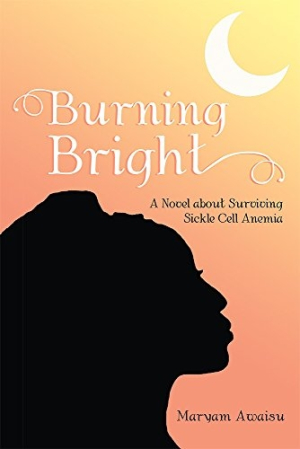
Burning Bright
A Novel about Surviving Sickle Cell Anemia
This complex and entertaining novels paints a portrait of life with sickle-cell anemia.
Most people have heard of sickle-cell anemia, but many don’t know much about it. In Burning Bright, Maryam Awaisu introduces people to the realities of living with this disease in a novel that is as entertaining as it is informative.
Nadia, the book’s protagonist, is a driven young woman who refuses to let her condition stop her from achieving her goals. However, years of enduring constant setbacks due to her illness have left her closed off to those around her. In wanting to show everyone how much she can do despite having sickle-cell anemia, she has lost the ability to let people in and accept help when she needs it.
Throughout this novel, Awaisu does a superb job of conveying not just the physical aspects of sickle-cell anemia, but the emotional impact it has on both Nadia and the people around her. “[Nadia’s] mother always dropped everything she was doing and made her the absolute priority whenever she was sick,” she writes. “It always made her feel loved, cherished and terrible at the same time.” Nadia is not a woman to be pitied—she is strong-willed and fiercely independent—but Awaisu also resists making her the absolute hero. She gives Nadia flaws, and this allows the novel to be complex and interesting beyond its role in informing the public about sickle-cell anemia.
Awaisu also shows the differences between those who have the means to pay for their care and the large number of Nigerians who are unable to afford the services they need. Nadia volunteers at a sickle-cell foundation in Kaduna, Nigeria, and frank descriptions of the physical characteristics of the patients who come to the clinic are contrasted with her own lack of outward signs of the disease. Without lecturing or overly dramatizing it, Awaisu makes it clear how much pain and suffering could be eased if the proper care were available to everyone.
Though Awaisu’s writing style is clean and to the point, it could be improved by the use of more diverse descriptions. Most of the details about people, places, and things in the book are visual. Utilizing the other four senses would bring her writing to the next level.
Overall, Awaisu has accomplished what she set out to do. She provides an entertaining and informative book that increases awareness and understanding of a disease that affects millions of people worldwide. In addition to spreading awareness, she is giving back by donating 40 percent of all profits from this book to sickle-cell and orphan charities in Nigeria. This novel is a wonderful choice for anyone interested in learning more about sickle-cell anemia and Nigeria, or those who enjoy books with strong female leads.
Reviewed by
Christine Canfield
Disclosure: This article is not an endorsement, but a review. The publisher of this book provided free copies of the book and paid a small fee to have their book reviewed by a professional reviewer. Foreword Reviews and Clarion Reviews make no guarantee that the publisher will receive a positive review. Foreword Magazine, Inc. is disclosing this in accordance with the Federal Trade Commission’s 16 CFR, Part 255.
